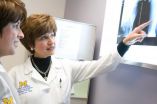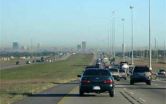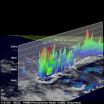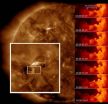(Press-News.org) VIENNNA, Austria – At the Comprehensive Nuclear-Test-Ban Treaty Organization (CTBTO) meeting this week, American researchers are unveiling a new tool for detecting illegal nuclear explosions: the Earth's global positioning system (GPS).
Even underground nuclear tests leave their mark on the part of the upper atmosphere known as the ionosphere, the researchers discovered, when they examined GPS data recorded the same day as a North Korean nuclear test in 2009. Within minutes on that day, GPS stations in nearby countries registered a change in ionospheric electron density, as a bubble of disturbed particles spread out from the test site and across the planet.
"Its as if the shockwave from the underground explosion caused the earth to 'punch up' into the atmosphere, creating another shockwave that pushed the air away from ground zero," said Ralph von Frese, professor of earth sciences at Ohio State University and senior author on the study.
Jihye Park, a doctoral student in geodetic science at the university, is presenting the results of the study this Wednesday, Thursday, and Friday in a poster session at the CTBTO meeting in Vienna, Austria.
International authorities already possess several methods for detecting illegal nuclear tests, Park said. Seismic detectors pick up shockwaves through land, and acoustic sensors monitor for shockwaves through water and the air for tests that happen above ground. Chemical sensors detect airborne radioactive gas and dust as definitive evidence of a nuclear explosion. However, these particles may be lacking if the explosion is contained deeply below ground.
"GPS is a complement to these other methods, and can help confirm that a nuclear test has taken place – especially when the test was underground, so that its effect in the air is very subtle, and otherwise nearly impossible to detect," she said.
While GPS was designed for location purposes, the technology has always been especially sensitive to atmospheric disturbances, said Dorota Grejner-Brzezinska, a professor of geodetic science at Ohio State and Park's advisor.
"GPS signals must pass from transmitters on satellites high above the planet down to ground-based receivers," Grejner-Brzezinska explained. "Air molecules – more specifically, the electrons and other charged particles in the ionosphere – interfere with the signal, generating position error. Part of our research concerns how to compensate for that vulnerability and make GPS work better. Jihye found a way to take that vulnerability and turn it into something useful."
Park wrote computer algorithms that search GPS signals for patterns indicating a sudden fluctuation in atmospheric electron density in specific locations, which is what happens when a shockwave pushes a bubble of air through the atmosphere. As the GPS signal passes through the edge of the bubble, the change in electron density disturbs the signal in a noticeable way.
Park was able to utilize data collected from GPS receivers that the International GNSS Service (IGS) has planted around the globe for research purposes. Five of the IGS receivers scattered in Eastern Asia provided data for this study, as did six receivers belonging to the South Korean GPS network.
When Park analyzed the data from the 11 GPS stations, she detected a sudden spike in atmospheric electron density after the May 25, 2009 underground test, which is believed to have happened just before 1:00 a.m. Coordinated Universal Time that day.
Within 25 minutes, the shockwave had traveled 225 miles to the nearest GPS station in the study, which was located in Inje County, in Gangwon Province, South Korea. That means that it was traveling through the air at 9 miles per minute, or 540 miles per hour. Within that first hour, it had reached all 11 stations.
Based on the timing of the shockwave, the researchers traced the origin of the explosion back to P'unggye, in Hamyong Province, North Korea. This finding agrees with seismic data from the event, which was collected by the CTBTO and the US Geological Survey.
The researchers will continue this work as Park earns her PhD, and they are seeking funding and partnerships to expand it further. In the meantime, they have submitted a paper on the discovery to the journal Geophysical Research Letters.
###
Collaborators on the study include Yu Morton, professor of electrical and computer engineering at Miami University in Oxford, Ohio, and Luis Gaya-Pique of CTBTO's On-Site Inspection Division.
Ralph von Frese, (614) 292-5635; Von-frese.3@osu.edu
Dorota Grejner-Brzezinska; DBrzezinska@osu.edu
Jihye Park; Park.898@osu.edu
Written by Pam Frost Gorder, (614) 292-9475; Gorder.1@osu.edu
GPS stations can detect clandestine nuclear tests
2011-06-08
ELSE PRESS RELEASES FROM THIS DATE:
Super-mini vehicles carry therapeutics and imaging agents into body with mega results
2011-06-08
Measured in billionths of a meter, self-assembling nano-sized devices designed to carry drugs and imaging agents into the body are revolutionizing medicine by improving drug solubility and bio-distribution, providing a platform for combining targeting and imaging agents, and enabling membrane barriers to be crossed as well as making drug and imaging agent combination therapies possible.
Self-assembling nano devices are now enlisted in the nanomedicine revolution, a story as told by researchers from Duke University and the University of Southern California in an article ...
ExpertPages.com - The Premier Expert Witness Site - Announces the Release of ExpertFinder, its Free iPhone/iPad App
2011-06-08
ExpertPages.com, the first and leading online directory for expert witnesses and consultants in litigation and forensic matters, today announced the release of its much anticipated iPhone and iPad ExpertFinder App. ExpertFinder enables attorneys and legal professionals to effortlessly and effectively identify and contact highly qualified experts from the palm of their hand.
The ExpertFinder App is available to lawyers and legal professionals for free in the App Store. The no cost download can be accessed on iTunes at http://expertpages.com/press/expertfinder.htm.
...
Drug shows promise in prostate cancer spread to bone
2011-06-08
ANN ARBOR, Mich. — A new drug to treat prostate cancer shows early promise, particularly against tumors that have spread to the bone, a multi-site study shows.
The drug Cabozantinib is designed to target mainly two important pathways linked to the growth and spread of prostate cancer. The drug had the most effect on tumors that had spread to the bone.
"Not only did three-quarters of bone scans have partial or complete resolution, but this was accompanied by improvement in bone pain and decreased need for narcotic use," says lead study author Maha Hussain, M.D., FACP, ...
Randy Heinitz Introduces Market Snapshot for the Palm Springs Real Estate Market Utilizing Real Time MLS Data; Get Your Property's Current Value Quickly Online
2011-06-08
Selling PS: It's So Sunny!, one of the Palm Springs area's most creative real estate marketing brands, has added Market Snapshot to their already user friendly website.
In an ongoing effort to enhance the consumer's experience on the website (http://www.SellingPS.com), Market Snapshot provides valuable and timely data, allowing consumers to simply click on the icon and instantly compare home prices in their neighborhood and get community and school information as well.
Market Snapshot provides up-to-the minute MLS graphical reports - automatically delivered and ...
Air quality worsened by paved surfaces
2011-06-08
New research focusing on the Houston area suggests that widespread urban development alters weather patterns in a way that can make it easier for pollutants to accumulate during warm summer weather instead of being blown out to sea.
The international study, led by the National Center for Atmospheric Research (NCAR), could have implications for the air quality of fast-growing coastal cities in the United States and other mid-latitude regions overseas.
The reason: the proliferation of strip malls, subdivisions and other paved areas may interfere with breezes needed to ...
NASA sees a hot tower in first tropical depression of the eastern Pacific
2011-06-08
The Tropical Rainfall Measuring Mission satellite called TRMM has the ability to see rainfall rates and heights of thunderstorm clouds within a tropical cyclone, and data from the satellite confirmed a "hot tower" near the center of the first tropical depression of the eastern Pacific Hurricane Season.
Tropical Depression 1E formed when the low pressure area called System 91E strengthened overnight. Today, June 7, Tropical Depression 1E (TD1E) was located about 365 miles (590 km) south of Acapulco, Mexico near 11.6 North and 100.0 West. It had maximum sustained winds ...
'Wrong'-time eating reduces fertility in fruit flies
2011-06-08
PHILADELPHIA - Dieticians will tell you it isn't healthy to eat late at night: it's a recipe for weight gain. In fruit flies, at least, there's another consequence: reduced fertility.
That's the conclusion of a new study this week in Cell Metabolism by researchers at the Perelman School of Medicine at the University of Pennsylvania, in which they manipulated circadian rhythms in fruit flies and measured the affect on egg-laying capacity.
Lead author Amita Sehgal, PhD, John Herr Musser Professor of Neuroscience, stresses, though, that what is true in flies grown in ...
Universal flu vaccine clinical trials show promise
2011-06-08
GALVESTON, Texas — A universal influenza vaccine targeting a protein common to all strains of influenza A has safely produced an immune response in humans. If proven effective, the vaccine could eliminate the practice of creating a new flu vaccine annually to match predicted strains, with major implications for global health.
The results of the clinical trials, led by the University of Texas Medical Branch at Galveston in collaboration with biotechnology company VaxInnate and funded by $9.5 million grant from the Bill and Melinda Gates Foundation, were published today ...
NASA's solar dynamics observatory catches 'surfer' waves on the sun
2011-06-08
Cue the surfing music. Scientists have spotted the iconic surfer's wave rolling through the atmosphere of the sun. This makes for more than just a nice photo-op: the waves hold clues as to how energy moves through that atmosphere, known as the corona.
Since scientists know how these kinds of waves -- initiated by a Kelvin-Helmholtz instability if you're being technical -- disperse energy in the water, they can use this information to better understand the corona. This in turn, may help solve an enduring mystery of why the corona is thousands of times hotter than originally ...
Bat Blue Supports World IPv6 Day
2011-06-08
Bat Blue Corporation, a provider of end-to-end network and security technologies and services, today announced that it will participate in World IPv6 Day on June 8th. World IPv6 Day is being organized by the Internet Society to motivate organizations to prepare their services for IPv6 to ensure a successful transition as IPv4 addresses deplete.
Bat Blue has been a proponent of IPv6 for several years and has had IPv6 enabled on its extreme-performance IP network, BlueNET, since 2008. During this time, Bat Blue has invested in many IPv6 peering relationships with other ...




